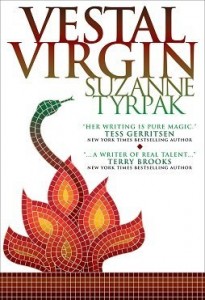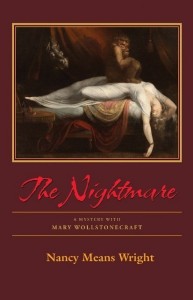 Relevant History welcomes historical suspense author Suzanne Tyrpak, who ran away from New York a long time ago to live in Colorado. Her debut novel, Vestal Virgin: Suspense in Ancient Rome, is set in Rome at the time of Nero, and Tess Gerritsen says, “Her writing is pure magic.” “Pure comedic brilliance” is how J.A. Konrath describes Suzanne’s collection of nine short stories, Dating My Vibrator. And Scott Nicholson says, “Enter this circus and let Suzanne show you why horror is the greatest show on earth” of Ghost Plane and Other Disturbing Tales. For more information, check her blog, and follow her on Facebook and Twitter.
Relevant History welcomes historical suspense author Suzanne Tyrpak, who ran away from New York a long time ago to live in Colorado. Her debut novel, Vestal Virgin: Suspense in Ancient Rome, is set in Rome at the time of Nero, and Tess Gerritsen says, “Her writing is pure magic.” “Pure comedic brilliance” is how J.A. Konrath describes Suzanne’s collection of nine short stories, Dating My Vibrator. And Scott Nicholson says, “Enter this circus and let Suzanne show you why horror is the greatest show on earth” of Ghost Plane and Other Disturbing Tales. For more information, check her blog, and follow her on Facebook and Twitter.
*****
Vestal Virgins have always been surrounded by mystery. We’ve heard the term “Vestal Virgin”—Procol Harum sings about them—but who were they? Priestesses of old who protected the sacred flame of the Roman goddess of the hearth, Vesta—in many ways this celibate sisterhood might be considered forerunners to the nuns of the Catholic Church.
 Vestal Virgins were the most powerful women in the Roman Empire. At a time when women had few rights and were treated like property, Vestal Virgins were revered. Unlike other Roman women, vestals were highly educated. And, although they lived a cloistered life, they had considerable freedom and participated in the world in ways denied to other women.
Vestal Virgins were the most powerful women in the Roman Empire. At a time when women had few rights and were treated like property, Vestal Virgins were revered. Unlike other Roman women, vestals were highly educated. And, although they lived a cloistered life, they had considerable freedom and participated in the world in ways denied to other women.
To be chosen a Vestal Virgin was a great honor, and candidates were usually daughters of leading Roman families. Only six women were designated as priestesses of Vesta, including the Vestal Maxima, who served as the head priestess, similar to a Mother Superior. When a position became available, a number of girls were nominated, but only one candidate was chosen by lottery. Vestals had to be free of physical imperfections, both parents had to be alive, and the girls (usually age six through ten) had to be virgins.
Though most women were completely dependent on men and could own no property, Vestal Virgins had financial independence. They could own property, and the state paid them substantial salaries. Though most Roman women weren’t taught to read or write, Vestal Virgins were highly literate. They scribed many legal documents, and important texts from throughout the empire were kept within the House of the Vestals.
The vestals wielded political and religious influence. They served as members of the Collegiate of Pontiffs, religious advisors to the Roman Senate. After the time of Julius Caesar, the head of the Collegiate of Pontiffs, the Roman Emperor was also appointed Pontifex Maximus. Consequently, the Vestal Virgins were in close contact with the emperor.
The vestals performed many public rituals and sacrifices throughout the year. For example: the harvest festival of Meditrinalia included a chariot race that began at dawn. The victor’s horse was sacrificed, its entrails smeared upon the altar of the Regia, where the Collegiate of Pontiffs resided. It was the job of the vestals to collect blood from the severed genitals to be used the following spring in order to ensure protection of flocks of sheep.
The priestesses of Vesta were believed to hold great power, therefore their blessings were solicited. People gave offerings to the priestesses to ensure that their loved ones would be included in the vestals’ prayers.
A privilege denied to most women was the popular entertainment of gladiator games. Chariot races took place in the morning, and women were welcome to attend, but afternoon brought games that ended in brutal death. The arena was cleared of women—except for the Vestal Virgins. In fact, the priestesses were designated their own box at the Circus Maximus, and the Coliseum, just below the emperor’s box.
Vestals were considered sacrosanct, and a vestal’s word was considered sacred. At times, her word could override an emperor’s. For example: a prisoner, sentenced to death, might escape his fate if pardoned by a Vestal Virgin.
 The six Vestal Virgins are, perhaps, best known for tending the sacred fire which represented the heart of Rome. Once a year, the fire was allowed to burn out. It would then be rekindled in a ritual, using a clear crystal and the rays of the sun.
The six Vestal Virgins are, perhaps, best known for tending the sacred fire which represented the heart of Rome. Once a year, the fire was allowed to burn out. It would then be rekindled in a ritual, using a clear crystal and the rays of the sun.
Because they tended the fire sacred to Vesta, virgin goddess of the hearth, the priestesses had to remain pure, and consequently vestals were pledged to thirty years of chastity on penalty of death. If suspected of breaking her vow, a vestal would face a trial with the Collegiate of Pontiffs and punishment to be doled out by the Pontifex Maximus. She might be tested in a variety of ways. For example: a vestal might be given a sieve in which she had to carry water from the Tiber river. No doubt, cheating did take place—smearing the sieve with grease might provide a way around the test. Or a vestal might be thrown into the river: if she sank, she would be considered pure, and, if she swam, she would be proved tainted—a test reminiscent of the much-later Salem witch trials. Once found guilty, a vestal would usually be sentenced to death. First, hair shorn and dressed in a drab robe instead of finery, she would be paraded through the streets, as if she were already dead. She would then be entombed alive with scant provisions and left to asphyxiate.
Of course, there were exceptions—not necessarily for the better. The emperor, Nero, for example, held himself above the law and is known to have raped at least one Vestal Virgin. The family name she bore was Rubria, but that is all we know of her. This gave me ample leeway, as a writer of fiction, to write my novel, Vestal Virgin: Suspense in Ancient Rome.
After serving for thirty years, Vestal Virgins were free to leave the order, but at a time in history when women were valued mostly for childbearing and life expectancy was short, what fate could a woman hope for in her late thirties? A vow of chastity might be a demanding price, but the rewards were great. Because of the power and freedom granted Vestal Virgins, rather than go to live with a male relative, many priestesses chose to remain in service.
*****
 A big thanks to Suzanne Tyrpak. She’ll give away one electronic copy of Vestal Virgin to someone who contributes a comment on my blog this week. I’ll choose the winner from among those who comment by Saturday at 6 p.m. ET.
A big thanks to Suzanne Tyrpak. She’ll give away one electronic copy of Vestal Virgin to someone who contributes a comment on my blog this week. I’ll choose the winner from among those who comment by Saturday at 6 p.m. ET.
**********
Did you like what you read? Learn about downloads, discounts, and special offers from Relevant History authors and Suzanne Adair. Subscribe to Suzanne’s free newsletter.


